How would I create a non-uniform random generation of gameObjects (enemies) that mimic the formation of a "horde" like this image:

I want there to be more gameObjects in the front and less as it trails off towards the back. I thought of making an Empty gameObject and having the enemies target with code like this:
public Vector3 target : Transform;
if (target == null && GameObject.FindWithTag("Empty"))
{
target = GameObject.FindWithTag("Empty").transform;
}
However, doing that would not give me the "trail" effect where there are fewer int he back.
Here is my code for randomly generating enemies, if it helps:
void SpawnHorde()
{
for (int i = 0; i < hordeCount; i++)
{
Vector3 spawnPosition = new Vector3(Random.Range (0, 200), 50, Random.Range (0, 200));
Instantiate(Resources.Load ("Prefabs/Sphere"), spawnPosition, Quaternion.identity);
}
}
Does anyone have a suggestion as to how to achieve this?
My results after implementing @Jerry's code:
More concentrated in the front; less in the back :)
